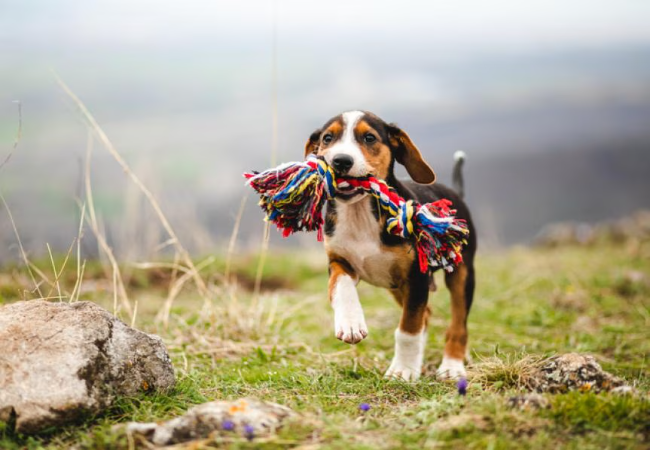When Can Puppy Go Outside 2025: Vet Guide for Safe Socialization 🐾

In this article
When Can Puppy Go Outside 2025: Vet Guide for Safe Socialization 🐾
By Dr. Duncan Houston BVSc
📤 Why Timing Matters
Puppies are born with some immunity from their mother, but this fades by around 8 weeks. Critical vaccinations (distemper, parvo, adenovirus) aren’t complete until about 16–20 weeks, with full protection ~2 weeks after the final vaccine—typically around 18 weeks old.
However, delaying socialization too long risks behavioral issues—AVSAB and behavior experts urge early, safe exposure.
🔹 What You Can Do by Age Stage
8–12 weeks: Home-Bound Freedom
- Your puppy can go outside in your fenced backyard if no sick animals have been around.
- Facilities like playdates with vaccinated dogs, stroller rides in public, and safe backyard exploration aid early mental growth.
12–16 weeks: Second Vaccine Set
- After the second round of shots (~12 weeks), you may begin short, cautious outings on clean surfaces—sidewalks, front yards, or patios—avoiding high-traffic dog areas.
- Continue indoor leash practice and introduce diverse surfaces and mild noises for desensitization.
16–18 weeks: Final Vaccine & Outdoor Transition
- Once the third vaccine set is complete (often by 16 weeks), wait 1–2 weeks per vaccine timing—around 18 weeks—before regular outdoor walking.
- Now it's safe for controlled public outings: neighborhood walks, beginner classes, pet stores—avoid dog parks until fully immune (~6 months recommended).
🧩 Socialization Before Full Vaccination
Use creative, low-risk exposure methods:
- Carry your puppy outdoors to experience sounds, sights, and smells without direct contact.
- Puppy-friendly classes where vaccination proof is required.
- Invite healthy, vaccinated dogs into your home or yard for controlled, positive play.
- Introduce household sounds and textures (traffic, vacuum, grass, wood floors) early on.
🚶 First Walks & Outdoor Adventures
- Start on quiet sidewalks or clean driveways avoiding high-traffic dog zones.
- Focus on fun and confidence—no overwhelming experiences yet.
- Use cross-surface exposure—pavement, grass, bark; introduce car rides in carrier or stroller.
⚠️ Safe vs. Risky Outdoor Locations
*2 weeks after final vaccine admin
| Location | When Allowed | Risk Level |
|---|---|---|
| Fenced Backyard | 8 weeks+ | Low |
| Home Playdates | 8 weeks+ | Low |
| Quiet Walks | 12–18 weeks* | Moderate |
| Puppy Class/Pet Store | 18+ weeks | Moderate |
| Dog Parks, Beaches | 6+ months | High |
👣 Potty Training Outside
- Start backyard sessions early—use praise and treat reinforcement.
- Use chosen potty spot consistently for habit building.
- Carry puppy outside before they’re vaccinated to prevent indoor accidents.
🛠 Dr Houston’s Outdoor Prep Checklist
- ✅ Complete core vaccine series (DAPP + rabies) by ~16 weeks
- ✅ Wait 1–2 weeks post-final booster before public outings
- ✅ Use backyard and controlled exposure early
- ✅ Carry them outside for social learning
- ✅ Practice leash and noise desensitization indoors
- ✅ Supervise initial walks, praise calm behavior
- ✅ Gradually introduce busier or off-leash spaces after 6 months
📌 When to Call Your Vet
- Mixing up vaccine timing? Ask your vet before outdoor sessions
- Puppy has diarrhea, vomiting or lethargy after outings
- You live in an area with parvovirus outbreaks
- Puppy seems fearful or overwhelmed—get behavioral support
🌟 Final Thoughts
The journey from home to neighborhood strolls is crucial, but safety relies on the correct vaccine timing—typically ~18 weeks for walks. Yet, the essential socialization window spans 8–16 weeks. By creating fun, low-risk experiences—like stroller rides, backyard playdates, indoor exposure to varied stimuli—you balance vital immunity and confidence building. With this thoughtful progression, your puppy grows into a healthy, happy dog ready for the world!
Need help with your puppy’s vaccine schedule, training, or socialization plan? Visit AskAVet.com or download the Ask A Vet app—your 24/7 veterinary partner. 📱🐶






